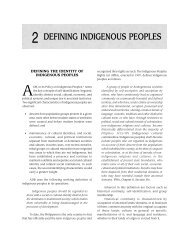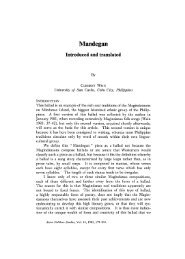BRIDGING THE GAP - Philippine Culture
BRIDGING THE GAP - Philippine Culture
BRIDGING THE GAP - Philippine Culture
Create successful ePaper yourself
Turn your PDF publications into a flip-book with our unique Google optimized e-Paper software.
<strong>BRIDGING</strong> <strong>THE</strong> <strong>GAP</strong><br />
Henry F. Funtecha, Ph.D.<br />
‘Bordon’: The West Bisayan merry mourning custom<br />
Among the inhabitants of Western Visayas, particularly those in Panay, there are many and<br />
oftentimes puzzling dos and donts that have to be observed upon the passing of a member of the<br />
family or the community. These are those that have become part and parcel of the customs and<br />
traditions of the people through time.<br />
Nevertheless, despite the sadness and sorrow felt due to the death of somebody, there seems to be<br />
time where everybody looked forward to, especially in the past when there were no televisions,<br />
cellphones, computers, and other modes of highly technologically-driven entertainment. These were<br />
the feast prepared on the burial day for the mourners and the “bilasyon” that follows in one<br />
“pasiyam” or of nine days of prayers and merrymaking.<br />
The purpose of the “bilasyon” is to comfort or ease the pains of the bereaved family for the passing<br />
away of a loved one. For some though, it is an opportunity to socialize with friends and meet<br />
possible future partners in life.<br />
The most interesting and exciting game during the “bilasyon” was the “Bordon”. It is sad, however,<br />
that this traditional exciting game is no longer practise nowadays, except perhaps in some remote<br />
areas.<br />
To play the “Bordon”, participants who are mostly young people, would form a big circle while<br />
seated on the floor. Generally, if the gender of the participants will permit, the seating arrangement<br />
would be boy-girl alternately. Thus, it will appear that the participants are actually couples. Inside<br />
this big circle is the “it” who may be variably called the “polis”, “hari”, “bastonero” or “kuring”.<br />
As soon as everybody is ready, the players clasp hands together and a ring is dropped at the clasped<br />
hands in one point of the circle while the group starts to sing the “bordon”. The “bordon” song,<br />
more or less runs this way: “Bordon de las kwerdas, singsing papanawa, palibut-libuta sa hari kag<br />
rayna. May mutyang trabungko, dalaga si Carmela nga maayo-ayo. Singsing ay abaw singsing...”<br />
(And, so on and so forth)<br />
Meanwhile, the “it” will try to locate where the ring is around the circle for it is concealed in the<br />
moving back and forth clasped hands of the participants. If he/she is able to locate or apprehend the<br />
holders of the ring, they are penalized through the recitation of a “loa” or even required to sing<br />
songs or a duet. This holds true to somebody or the partners who accidentally drop the ring on the<br />
floor.<br />
The “loa” or “lowa” is a quatrain rhymed in a number of ways, like a,b,a,a,a,a,b,b, or a,a,a,a,, etc.<br />
(Padilla 1994). Examples of loa are here given: (1)”Sa ibabaw sang bukid, may tambo nga<br />
nagaligid, Nagaligid, nagabalang-balang, Nagapangita sang tagabang.” (2) “Mga rosas sa<br />
kabulakan, Bulak sang kamantulan, Soltero nga waay nobya, Nagamantenir saging sab-a.” One that<br />
is very familiar with and always recited by young girls is this one: “Paghalin ko sa balay, Nagbilin<br />
si Nanay, Sanglit ako malaw-ay, Magpahigad-higad lang anay.”
There are also loas that are funny or often absurd and a few that are lewd and vulgar. Take a look at<br />
these ones: (1) “Si sin-o ang tampalasan, Ang namus-on sa sini nga dalan, Sa banta ko babaye, Kay<br />
ang ihi malapit sa ta-i.” (2) Sa ibabaw sang paho, May balo nga nagapungko, Hinaboy ko gamay<br />
hal-o, Hala! Fight! Bato!”<br />
If this type of loas is resorted to by some participants, the older folks present may interrupt and say<br />
“Estangko!” which means “unacceptable” and so the one penalized may have to resort to other loas.<br />
As to the rest of the participants, they may likewise react by way of shouting “Bitor!” when they are<br />
in approval and may sing “Tatay Meroy waay datsoy!” if unacceptable. With this, the person<br />
concerned has to try again or be meted the penalty.<br />
Another variant of the “Bordon” is called the “Panyong Palaran”. The game also start with the same<br />
seating arrangement mentioned earlier but, this time, there are more specific persons in target by the<br />
“it”. The game also starts with a song that runs like this: Tintin ka na uwak, hapon sa amargoso,<br />
Amargosong mapait, solterong maanghit, Amo ining katapusan sang anom ka verso, Panyo nga<br />
palaran, itaklop sa ulo”. The “it” puts the handkerchief on the head of whoever he wants to deliver<br />
the loa.<br />
At times, when a male participant gets attracted to a female player, especially a new face, only the<br />
two of them take turn in putting the handkerchief on each other’s head. Here’s what they say: Male:<br />
“Aton palapitan isa ka prinsesa nga nagapanilong sa puno sang granada, Basi mabuyok ang pensar<br />
niya, Nga sa akon siya mamana.” Female: “Hardin gali ini sang paraiso, Apang maiwat gid<br />
magbaton estado, Maayo kon manami ang madangatan ko, Pero kon malain, kaloluoy man ako.”<br />
Male: “Ay, abaw si Inday wala gid kalooy, Sang pagbalakhoon ni Nonoy, Bisan pa gani ang gabok<br />
nga kahoy, Nagatakas-takas kon ako managhoy.” Female: “Dili ako magpati sa imo sugid, Kay<br />
akon natandaan sa libro ni David, Nga ang imo ginasugid, Lunsay lang gid mga binutig.”<br />
As one can see, the West Bisayans have a very rich oral traditional literature. Before everything is<br />
lost to the overwhelming effects of modernization and globalization, scholars and students should<br />
find the time to record this very interesting non-material cultural heritage of the West Visayan<br />
region. Those who belong to the present owe it to the future generation to preserve components of<br />
this merry mourning tradition.

















